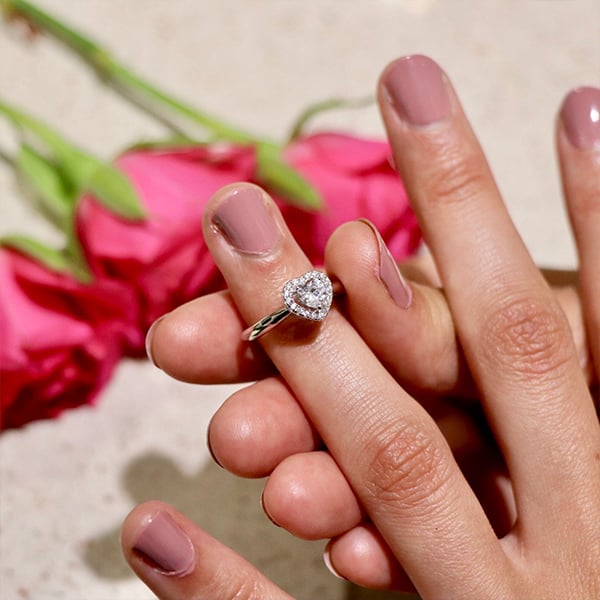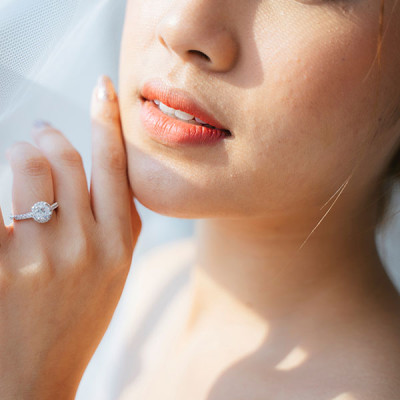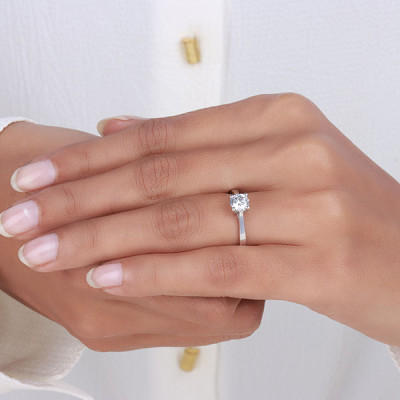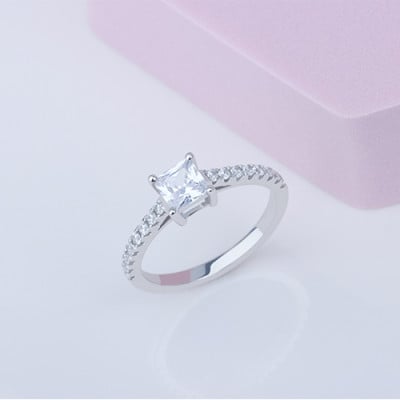Which Finger is the Ring Finger?
24th April 2022 By Nilesh Rakholia
Quicklinks
Every ring you wear says something about you and can convey a statement about your personality, your beliefs and your life. Wedding rings, engagement rings and promise rings have a deep symbolism. Even how you wear them tells a story to others.
Which Is The Ring Finger?

Put simply, the ring finger is the finger you choose to wear your wedding ring on. Wedding rings are often worn to symbolize the bond of a marriage between two people, showing their love and commitment to one another.
If you don’t know your ring finger from your index finger, your engagement ring finger from your wedding ring finger, you may be wondering just what is the ring finger, even which one is the ring finger which hand is the ring finger on. And if you’re just all fingers and thumbs and planning to buy a ring for someone special, read our ring size guide now to avoid either making a faux pas or breaking convention completely (unless you want to!).
Whilst there are certainly no laws surrounding which finger you should wear your wedding ring on, the ring finger is most commonly recognized as the fourth finger from the thumb on the left hand. If you attend a wedding ceremony in the UK, it is more than likely you will see both partners exchanging rings on this finger.

Which Is The Wedding Ring Finger?
So, which finger should I wear my wedding ring on? In Western cultures, couples exchange wedding rings after their vows during the ceremony. The wedding ring is traditionally worn on the left hand as this side is closest to the heart. A wedding band is usually worn on the fourth finger, commonly known as the ring finger.
Slightly confusingly, if you’re used to counting from left to right - on the left hand, the fourth finger is the digit fourth from and including the thumb. That is, it’s the finger between your little one (‘pinkie’) and your middle finger. This tradition is said to date back to Ancient Egyptian
times when people believed there was a vein that ran from the ring finger directly to the heart. There isn’t actually such a vein there, but symbolism endures to this day.
Wearing a wedding ring on the left hand also makes practical sense for many people. After all, 90% of us are right-handed so this makes it less likely the ring will snag or be damaged as we go about our daily lives. There’s nothing to stop anyone wearing a wedding ring on their right hand should they prefer though. In many cultures, including Jewish and Orthodox Christians, and in plenty of countries, it is traditional to opt the right hand rather than left for your wedding ring finger.

Which is the Engagement Ring Finger?
So, which finger should I wear my engagement ring on? Many cultures and people in many nations continue the ages-old tradition of also wearing an engagement ring on the fourth finger of the left hand. Once that person is married, the wedding ring goes first with the engagement ring placed directly after. It’s likely that this custom reflects marriage trumping engagement in terms of ceremony and commitment.
That said, there are lots of people who choose the right hand for their engagement ring finger. Indeed, in some countries, both wedding and engagement rings are customarily worn on the
right. Perhaps loved-up folks in Switzerland have the right idea. The Swiss typically wear their engagement ring on the right ring finger and wedding band on the left. Maybe that makes sense from a statement perspective, with both hands adorned by something attractive and meaningful.
The ancient tradition of only women wearing engagement rings is based on somewhat archaic principles that linger now as ‘what we’ve always done’. In the olden days, the engagement ring was a form of insurance or promise of marriage. Should he get cold feet, the bride-no-longer-to-be had something of value to make up for her disappointment. A cynic might add that chaps also liked hiding their ‘taken’ status for as long as possible before the wedding.
Either way, more and more men and of course couples of the same sex and gender are choosing to wear engagement rings. Conversely, some women simply choose not to have an engagement ring at all. Engagement rings are often stunning though so perhaps both members of a couple really should don one.

What finger does a promise ring go on?
Promise rings are an interesting concept and one that perhaps needs a little thought. Lots of people have never even heard of such a thing and ask what is a promise ring? A promise ring is given and accepted as a symbol of commitment. They’re not necessarily an undertaking to get wed or engaged, though they are sometimes referred to as a pre-engagement ring. Promise rings are also often used when people renew their wedding vows - much like an eternity ring.
In truth, a promise ring means whatever you intend it to. It can also be an expression of a heartfelt friendship that will endure. In some parts of the world where same-sex weddings or civil unions are forbidden, they can be a statement of faithfulness between members of the LGBT+ community. As for fingers, it’s widely accepted that promise rings be worn on any finger you like. Some people like to incorporate them into a wider trend of stacked jewellery statements by wearing them on their ring finger alongside a wedding and engagement ring.

Which hand is a Trilogy ring worn on?
1. Wear it on your right hand: Asides from wearing it on your left hand, it can also be worn on the third finger of your right hand, as it is in most cultures in countries like Russia, Greece, and Columbia. However, wearing it on your right hand can be your personal choice and not dictated by culture.
2. Wear it on top of your wedding band: Just like an engagement ring, after deciding what hand you’ll wear your trilogy ring on, you may want to consider how you will wear it after the wedding ceremony. You may most likely wear your trilogy ring on top of your wedding ring.
3. Alternate Rings: You can decide to wear your wedding ring every day and reserve their trilogy engagement ring only for special occasions, or you can decide to wear your trilogy engagement rings all the time and keep your wedding band for special occasions. The choice is yours.
What does a ring on different fingers mean?
Throughout time, wearing a ring on different fingers has developed certain meanings, for example:
● Two rings on the left little finger: Now fallen out of favour, a wedding ring and a signet ring on the left pinkie once also indicated that a man was married.

● Left index finger: Reserved for royalty, subjects would kneel and kiss the ring on this finger. Today it’s a great place to stack jewelry too.

● Either middle finger: While there’s no particular meaning here, because this is the longest digit wearing a ring on it can make it really stand out.
● Left and right thumb: Wearing a ring here has long been a symbol of wealth, but these days it’s also to make a statement of unconventionality.

In the modern world, many meanings for wearing rings on different fingers have either faded a little or been adopted for fashion reasons. All in all, wear whatever ring you choose and do it with confidence and style.
We provide a free ring sizer for you to identify your correct size to identify the right size, width and profile of your ring.
Cultural Differences
Traditionally, in Western culture, wedding rings have always been worn on the left hand. This is true of countries such as the UK, US, France, Portugal, Switzerland, Australia, and Canada.
This tradition dates back to the 11th century. In medieval Europe, during Christian betrothal ceremonies, men would bless the ring and place it on their wives’ fingers on their left hand in a sequence, starting from their thumb, and ending on their fourth finger, where the ring would stay.
Men also didn’t typically wear wedding rings in the past, these were reserved for women. In the UK, only women wore wedding rings up until the 20th century. However, as the First and Second World Wars began, men decided to start wearing wedding rings to remind them of their wives whilst they were away fighting.
However, within Western culture, there also exists several countries who choose to put their wedding ring on their right hand.
Typical of Orthodox countries across Eastern Europe, including Bulgaria, Greece, Latvia, and Ukraine, as well as some Western European countries, including Austria, Germany, Hungary, and the Netherlands, wedding rings are worn on the fourth finger of the right hand.
Countries such as Turkey, Lebanon, Romania, and Brazil typically wear their wedding rings on their right hand up until the day of the wedding ceremony, when the ring is then moved to their left hand.
Islamic Countries: Wedding rings aren’t commonplace during Islamic weddings; however, when wedding rings are used, they are typically worn on the left hand. Instead of using traditional weddings rings, Islamic countries often use rings to symbolize betrothal or engagement. If these rings are worn, they are typically worn on the fourth finger on the right hand by men, and the fourth finger on the left hand by women.
Jewish Weddings: In a traditional Jewish wedding, the wedding ring is typically placed on the bride's righthand index finger. However, other traditions have been known to place the ring on the middle finger or thumb.
However, more recently after the ceremony, the ring is moved onto the left-hand ring finger. Also, whilst some Jewish men have started to wear engagement rings, under Orthodox Judaism, men do not typically wear wedding rings.
Same-Sex Weddings: Whilst same-sex marriage is now legal across much of the western world, this is only a recent occurrence. Before this, some countries allowed same-sex couples to enter civil partnerships instead.
During this time, many same-sex couples chose to wear commitment rings, which they would wear on their right-hand ring finger, to symbolize their commitment to one another. However, as same-sex marriage became legal, many couples adopted the traditional left-hand ring finger during ceremonies.
Conclusion
It may sound like a silly question to some, but it’s important to know what is the ring finger and which hand is the ring finger? The last thing you want to do is fumble at the alter as you try to remember which finger it is that you need to put the ring on for your very-soon to be partner.
To make matters more confusing, the symbolic ‘ring finger’ isn’t universal; different cultures use different fingers for engagement and wedding rings as they believe different fingers hold different meanings.
Ultimately, there are no laws around which finger you place your wedding ring on; choosing to wear it on a different finger won’t alert the attention of the police. However, local culture and traditions typically decide which finger you choose to wear your wedding ring on.
No matter which finger you choose, ABELINI has a great selection of stunning wedding and engagement rings to choose from and are guaranteed to make your day even more special.
FAQs
Try a generous dollop of lubricant such as soap, petroleum jelly or baby oil and twist the ring back and forth while gently pulling. Or try submerging your finger in a cup of ice cold water for about 10 minutes to reduce the swelling and add some lubricant. If the worst comes to the worst, most jewellers will have a special tool called a ring cutter (as will A&E departments!).
Wrap string around the base of your finger, mark where the ends meet and measure with a ruler. Alternatively, you can buy ring sizers online or visit a jeweller to be measured.
Traditionally, signet rings are worn on the pinkie of the non-dominant hand. It’s also quite common for signet rings to be worn on the middle finger of either hand.
Yes! The choice often comes down to personal preference or customs. Some women prefer to wear their engagement ring on their right ring finger, and wedding ring on the left ring finger. In some places, the traditional way of wearing a ring, the engagement ring is transferred to the right hand on the wedding day, so the wedding ring can be worn on the left hand, and after the ceremony, the engagement ring is transferred back to the left hand, on top of the wedding ring. You can choose different ways to wear your rings, whether you wear them on different hands or wear them together so they become one, the choice is yours.
Your engagement ring or wedding ring finger doesn't necessarily have to be your left hand. It's perfectly normal to wear you’re your rings on either hand and on any finger. In some cases, you may not even need to wear a ring at all, whatever you and your partner decide according to your tradition and lifestyle. You don’t have to follow any tradition; you make the rules!

Article written by Nilesh
 Trustpilot
Trustpilot



